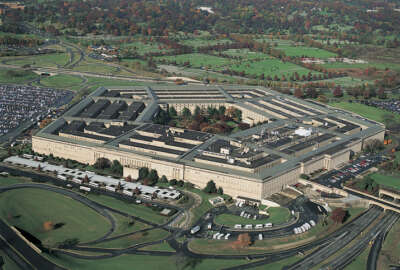
Among DoD leadership, eyes are now wide open to value of telework
Defense officials say COVID-19 "shattered the myth" that employees can't be productive while teleworking. In many cases, they're more productive than ever.
The DoD Reporter’s Notebook is a weekly summary of personnel, acquisition, technology and management stories that may have fallen below your radar during the past week, but are nonetheless important. It’s compiled and published each Monday by Federal News Network DoD reporters Jared Serbu and Scott Maucione.
The telework results are in and they’re changing DoD
The Defense Department may never look the same when it comes to working remotely. The coronavirus opened leadership’s eyes to the possibilities of telework, and last week top officials let the public know about it.
“We really shattered the myth that you can’t do any work at DoD via a telework situation,” Lisa Hershman, DoD’s chief management officer said.
The Pentagon’s old excuse for restricting telework was that people needed access to classified information and those people need to be on secure networks to tap into it.
“What we learned very quickly was that not everyone works with classified information, and even those that do, it’s not 100% of the time,” Hershman said. “We have started to relook at what is the mix, if we look at certain positions and the position descriptions, how much of it is feasible to do in a telework situation?”
Hershman has experts on her team examining how often people need to be in the office and talking to employees to see what their prime balance of telework and in-person work entails.
“We found in some situations, especially highly transactional work, employees were more productive,” she said. “In one instance, in Washington Headquarters Services, we had an individual that was 30% more productive. When we asked why they indicated a lot fewer interruptions and a lot fewer meetings that they have to attend. We’re learning from that and capturing that information.”
Chief of Navy Personnel Vice Adm. John Nowell agreed.
“It certainly removes distractions,” he said. “Teleworking has helped us be very efficient and very productive, and I think it’s true for the entire Navy that what we look like on the tail end of this as we come out of it and how we manage and lead our workforce will be different than pre-COVID.”
Almost all of Nowell’s workforce is teleworking, more than 700 people. Before coronavirus, his office only had about 5% of employees teleworking.
Nowell said in a post-COVID world that he imagines a hybrid situation where people work from home a few days, and then come into the office for some events or for access to classified information.
He added that the money the Navy can save in office space by doing that can go into runways and harbors.
Rebecca Weirick, the executive director of the Services Acquisition Office of the deputy assistant Army secretary for procurement, said teleworking is saving money for both the Army, its employees and contractors.
She wants to entrench some of the teleworking habits.
“I’ve asked my team to write some policy ahead of necessity to allow contractors to telework into the future,” Weirick said. “We’ll see where that goes. It’s got to get through a little bit of rulemaking here in the Army to make sure that everybody’s comfortable with that. But the cost savings, the savings on commuting, the savings on employing people from all over the world really opens up a big diverse workforce opportunity for us where we’re not just employing people in the state.”
Officials said teleworking may be a recruiting tool as well. Commands can recruit people who aren’t willing to move to where headquarters are, and people may be more open to working for DoD if it can offer a more flexible working environment.
Undersecretary for Acquisition and Sustainment Ellen Lord commended Chief Information Officer Dana Deasy for keeping the bandwidth open to allow so many people to start teleworking at once during the beginning of the pandemic.
“During calls people are in their dining rooms and living rooms and home offices and we all just kind of go with the flow,” she said. — SM
Morrison picked to lead part of Army’s revamped IT leadership structure
We now know who will lead the Army’s newly-redesigned IT governance structure when it takes effect later this year. Well, half of it anyway.
The Pentagon has nominated Maj. Gen. John Morrison to become the “G-6” half of the Army CIO/G-6 when the Army separates the two roles this fall. Since the early 2000s, both functions have been performed by a single three-star general, but that’s changing under a restructuring officials announced last month.
Morrison is currently the chief of staff at U.S. Cyber Command; before that has was the commanding general of the Army’s Cyber Center of Excellence at Fort Gordon Ga., and has also served as commander of the Army’s Network Enterprise Technology Command at Fort Huachuca, Ariz.
Morrison’s G-6 nomination would come with a promotion to lieutenant general, the same rank held by the rest of the Army’s deputy chiefs of staff.
Morrison’s nomination was first reported by C4ISRNET.
The Army has not yet announced who will become the CIO once that role becomes an independent position, but it’s likely to be a senior civilian official. Lt. Gen. Bruce Crawford, the current and final CIO/G-6 told reporters last month that the CIO is likely to focus mainly in developing the Army’s IT budget and policy, while the G-6 will focus mainly on execution. But the changes are likely to take three to four years to fully come into effect. —JS
Slow goings on continued 5000 series updates
The Pentagon has been working on rewriting it acquisition policy for a while now, and with the help of Congress, it’s reformed a large part of how it procures systems.
However, coronavirus threw a wrench in that progress. The Defense Department was consistently putting out new guidance updating its 5000 series, the bible of procurement policy. In the past it released new guidance on buying major weapons systems, hiring services and general overarching guidelines.
Now, says Assistant Defense Secretary for Acquisition Kevin Fahey, those updates are coming to a standstill.
“Because of COVID we are traveling a lot and we don’t have big group meetings,” he said. “The 5000 series update is probably one of those areas that is not progressing as much as we’d like to this year.”
Some of the things DoD wanted to focus on were incorporating mission engineering into procurement. It also wanted better portfolio management across the department and focus on more data driven acquisition.
DoD was using the Defense Acquisition University as a way of building out some of its ideas.
DoD used DAU to flesh out questions and case studies about other transaction authorities and mid-tier acquisition. — SM
Army set to expand new talent management-focused approach to command selection
The Army has been testing out a new approach that tries to take a more holistic look at its military officers before they’re chosen for command — and it likes what it’s seen so far — so much so that officials are getting ready to expand it.
In January and February, the Army ran the first iteration of its new Battalion Commanders Assessment Program (BCAP). Instead of having selection boards pick officers for command based solely on their paper records, the Army sent 750 candidates through a more rigorous five day screening program at Fort Knox.
Each officer went through a blind interview, psychometric testing, verbal and written communication tests, and the Army’s new physical fitness tests. Out of the 436 officers picked for command through the BCAP process, 36% never would have made it under the traditional board-based system, said Maj. Gen. J.P. McGee, the director of the Army Talent Management Task Force.
“There are 150 different names of officers going into command based on this new process, and then attendant to that, we have all of this new information we were able to gather on the 750 candidates that came forward,” McGee said at an online conference hosted by AFCEA International last week. “Over time, we think that information is going to be transformative in terms of the insights we have about our officer corps, where their strengths and weakness lie, and how they can move forward.”
The Army is planning another round of BCAP in October and November, but based on the first year’s results, it’s already planning to expand the concept. In September, it will use a similar process to pick its next crop of colonels to be brigade commanders. —JS
Acquisition getting back on track
Defense Undersecretary for Acquisition and Sustainment Ellen Lord predicted a three-month delay for major acquisition systems after the coronavirus took hold of the nation.
As it turns out, things weren’t so bad.
“We have made amazing inroads in coming back up to close to the prior productivity levels,” she said.
There are still areas where DoD is cautious though. Aircraft suppliers are taking a particularly hard hit, especially ones that dabble in both the defense and commercial sectors.
“Sometimes that’s helpful to us because they’ve been able to shift critical resources over to our programs,” Lord said. “We do have to make sure that they are right sizing because obviously we can’t adjust all the overhead costs that would go with a full up dual use operation. A lot of work is going on and tough decisions being made, but we are pushing through it.”
The Army reported at the end of May that very few of its major acquisition systems would miss initial deliver dates. Some programs will have adjustments to milestones and benchmarks.
One of the major programs that will see delays is the Integrated Air and Missile Defense Battle Command System, a command and control weapon that shows a single view of the battlespace.
“The date we promised the solider they’d have that ability has not slipped, but we will adjust within the schedule,” Futures Command leader Gen. Mike Murray said. “We just added the checks to this event coming up.” — SM
Copyright © 2025 Federal News Network. All rights reserved. This website is not intended for users located within the European Economic Area.
Scott Maucione is a defense reporter for Federal News Network and reports on human capital, workforce and the Defense Department at-large.
Follow @smaucioneWFED
Jared Serbu is deputy editor of Federal News Network and reports on the Defense Department’s contracting, legislative, workforce and IT issues.
Follow @jserbuWFED
Related Stories






